Students should refer to Previous Year Questions ICSE Class 10 Physics Refraction Of Light with solutions that have been prepared by expert teachers of ICSE Class 10 Physics. These questions and solutions are based on past year papers that have come in examinations of ICSE Class 10. Students should understand the type of questions asked and the solutions provided. Also refer to ICSE Class 10 Physics Solutions
ICSE Class 10 Physics Refraction Of Light Last Year Questions
Students should learn the important questions and answers given below for Chapter Refraction Of Light in Physics for ICSE Class 10. These board questions are expected to come in the upcoming exams. Students of ICSE Class 10th should go through the board exams questions and answers for ICSE Class 10 Physics which will help them to get more marks in exams.
Board Exam Questions Refraction Of Light ICSE Class 10 Physics
Previous Year Questions ICSE Class 10 Physics Refraction Of Light
Very Short Answer Type Questions
Question; Name one factor that affects the lateral displacement of light as it passes though a
rectangular glass slab.
Answer: Thickness of glass slab/angle of incidence/ refractive index of glass/colour of light i wavelength of light
Question: Name one property of waves that do not change when the wave passes from one medium to another.
Answer: Frequency.
Question: How is the refractive index of a medium related to its real depth and apparent depth?
Answer: Refractive index = Real depth / Apparent depth
Question: How does the speed of light in glass change on increasing the wavelength of light?
Answer: The speed of light in glass increases on increasing the wavelength of light in glass.
Question: For which colour, violet or red, the refractive index of a medium is smaller ?
Answer: μR < μV
i.e., refractive index for red colour is less than that of violet colour.
Question: How is refractive index of a medium related to the speed of light in it?
Answer: Refracted index of medium
= Speed of light in air/vacuum / Speed of light in medium
aμm = c / vm
Question: How does the refractive index of a medium depends on the wavelength of light used?
Sol. Refractive index of a medium decreases with increase in wavelength of light.
Question: The refractive index of water with respect to air is 4/3. What is the refractive index of air with respect to water?
Answer: If aμw = 4 / 3 then wμa = 1 / allw = ¾.
Question: Which is greater, angle of incidence or angle of refraction, when light travels from denser medium
to rarer medium.
Answer: i < r.
Short Answer Type Questions I
Question: How is the refractive index of a material related to :
(i) Real and apparent depth?
(ii) Velocity of light in vacuum or air and the velocity of light in a given medium?
Answer: (i) Refractive index μ = Real depth (R.D.) / Apparent Depth (A.D.)
(ii) Refractive index aμm = c / v
where, c = speed of light in air/vacuum, and
v = speed of light in medium
Question: Draw a ray diagram to show the refraction of a monochromatic ray though a prism when it suffers
minimum deviation.
Answer:

δ = angle of deviation
A = angle of prism
PQ | | BC
i = e, r1 = r2
Question: When a ray of light passes from air to glass, for what angle of incidence, the ray will not be deviated.
Answer: If the angle of incidence, ∠ i = 0, the rays will not be deviated.
Q. 4. Draw a ray diagram to illustrate how a ray of light incident obliquely on one face of a rectangular glass slab of uniform thickness emerges.
Answer:

Question: A coin at the bottom of a trough containing water to a depth of 15 cm appears to be 3.75 cm raised
above from the bottom. Calculate the refractive index of water.
Answer: Real depth of coin = 15 cm
Raised above = 3.75 cm
Apparent depth of coin
= 15 – 3.75 = 11.25 cm
Refractive index = ?
Refractive index = Real depth of coin / Apparent depth of coin
= 15 / 11.25 = 1.33
Question: State the condition required for total internal refraction of light to take place.
Answer: (i) Light should travel from denser medium to the surface interacting with rarer medium.
(ii) Angle of incident should be greater than the critical angle for the pair of media.
Question: A boy uses blue colour of light to find the refractive index of glass. He then repeat the experiment using red colour of light. Will the refractive index be the same or different in the two cases? Given a reason to support your answer.
Answer: Refractive index will be different,
aμg = sin i / sin r
Different colours will have different angle of refractive even if the angle of incidence is the same therefore refraction index will be different
OR
speed of red colour and blue colour of light in air or vacuum is the same but in glass it is different. So refractive index of glass will be different as
aμg = c / vg
μg = velocity of light in glass which is different for different colours.
Question: State the dependence of angle of deviation of light while passing through the prism :
(i) On the refractive index of the material of the prism.
(ii) On the wavelength of light.
Answer: (i) Angle of deviation decreases with the decrease in refractive index,
(ii) Angle of deviation decreases with the increase in wavelength.
Question: Copy the diagram given below and complete the path of light ray till it emerges out of the prism.
The critical angle of glass is 42° In your diagram mark the angles wherever necessary.

Answer:
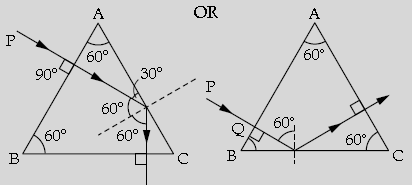
Question: The speed of light in glass in 2 × 105 km/s. What is the refractive index of glass?
Answer: Refractive index of glass =
Speed of light in vacuum / Speed of light in glass
=3X108 / 2X105X1000
=1.5
Question: Draw the diagram given below and clearly show the path taken by the emergent ray?
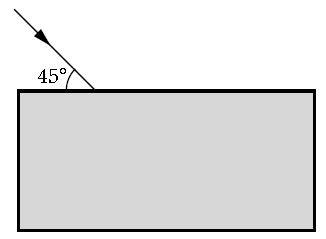
Answer:
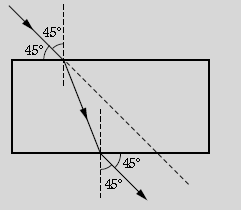
Question: (i) A ray of light passes from water to air, How does the speed of light change?
(ii) Which colour of light travels fastest in any medium except air?
Answer: (i) Speed of light increases.
(ii) Red.
Question: Light passes through a rectangular glass slab and through a triangular glass prism. In what way
does the direction of the two emergent beams differ and why?
Answer: In a glass slab, the emergent ray is laterally displaced because the two refracting surfaces are parallel to each other whereas in case of prism the emergent ray is deviated because two refracting surfaces are inclined at an angle A.
Question: Name the factors affecting the critical angle for the pair of media.
Answer: Wavelength of light temperature of medium refractive index of the pair of media.
Question: A ray of light is moving from a rarer medium to a denser medium and strikes a plane mirror placed at
90° to the direction of the ray as shown in the diagram

(i) Copy the diagram and mark arrows to show the path of the ray of light after it is reflected from the mirror.
(ii) Name the principle you have used to mark the arrow to show the direction of the ray.
Answer:

(ii) The principal of reversibility is used to mark the arrow to show the direction of refractive ray.
Question: (i) The refractive index of glass with respect to air is 1.5, what is the value of refractive index
of air with respect to glass?
(ii) A ray of light is incident as a normal ray on the surface of separation of two different mediums. What is the value of the angle of incidence in this case?
Answer: (i) Given refractive index of glass air i.e., aμg = 1.5
Refractive index of air with glass i.e., = 1 / aμg
= 1 / aμg = 1 / 5 = 2 / 3 = 0.667.
(ii) The value of angle of incidence is zero.
Question:. A ray of light incident at an angle of incidence I passes though an equilateral glass prism such that
the refractive ray inside the prism is parallel to its base and emerges from the prism at an angle of emergence e.
(i) How is the angle of emergence e related to the angle on incidence i?
(ii) What can you say about the value of angle of deviation in such a situation ?
Answer: (i) The angle of incidence ∠i is equal to angle of emergence ∠e. i.e., ∠i = ∠e
(ii) Inside the prism, the refracted ray is parallel to its base and the angle of deviation is minimum in this situation.
Question: (i) Define the term refractive index of a medium in terms of velocity of light.
(ii) A ray of light move from rarer medium to denser medium as shown in the diagram.
Write down the number of the ray which represents the partially refracted ray.

Answer: (i) The refractive index of a medium is the ratio of speed of light in vacuum to the speed of light
in that medium. it is expressed as
μ = Velocity (or speed) of light in vacuum / Velocity (or speed) of light in medium
(ii) Ray 2 represents the partially reflected ray.
Question: A ray monochromatic light enters a liquid from air as shown in the diagram given below :

i) Copy the diagram and show in the diagram the path of the ray of light after it strikes the mirror and re-enters the medium of air.
(ii) Mark in your diagram the two angles on the surface of separation, where the ray of light moves out from the liquid to air.
Answer: The following diagram shows the path of the ray of light after striking on the mirror and the two angle
on the mirror and the two angles on the surface of separation.

Question: In the given diagram, PQ is a ray of light incident on a rectangular glass block.
(i) Copy the diagram and complete the path of the ray of light through the glass block. In your diagram, mark the angle of incidence by letter i and the angle of emergence by the letter e.
(ii) How are the angle i and e related to each other?

Answer:

(ii) The angle of incidence is equal to angle of emergence i.e., ∠i = ∠e
Question: The refractive index of diamond is 2.42. what is meant by this statement?
Answer: The refractive index of diamond is 2.42 means that
the speed of light in diamond will become 1 / 2.42
times the speed of light in vacuum.
i.e., = Speed of light in vacuum / Speed of light in diamond = 2.42
Question: (i) What is meant by refraction of light?
(ii) What is the cause of refraction of light?
Answer: (i) Refraction of light is a phenomenon in which a ray of light passing from one transparent medium to another transparent medium changes its direction.
(ii) The main cause of refraction of light is different speeds of light in different media.
Question: A ray of light enters a glass slab PQRS, as shown in the diagram. The critical angle of the glass is 42°. Copy this diagram and complete the path of the ray till it emerges from the glass slab. Mark the angles in the diagram wherever necessary.

Answer: The diagram is redrawn as
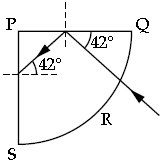
Question: State the conditions required for total internal reflection of light to take place.
Answer: The conditions required for total internal reflection of light to take place are
(i) The light must travel from a denser medium to a rarer medium.
(ii) The angle of incidence must be greater than the critical angle for the pair of media.
Question: A ray of light strikes the surface of a rectangular glass block such that the angle of incidence is
(i) 0 and (ii) 42°. Sketch a diagram to show the approximate path taken by the ray in each case as it passes through the glass block and emerges.
Answer:
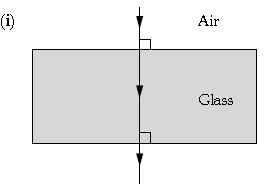
Given, ∠i = 0 ∴ ∠e = 0
(ii) Given, ∠i = 42°
∴ ∠e = 42

Question: (i) A monochromatic beam of light of wavelength λ passes from air into the glass block. Write an
expression to show the relation between the speed of light in air and the speed of light in glass.
(ii) As the ray of light passes from air to glass, state how the wavelength of light changes.
Does it increase, decrease or remain constant?
Answer: (i) The relation is given by :
Refractive index,
μ = Speed of light in air (Va) / Speed of light in glass (Vg)
(ii) The refractive index is inversely proportional to wavelength i.e.,
μ =1 / λ
Wavelength in glass g = λa / agμ
i.e., wavelength decreases.
Question: State Snell’s law of refraction of light.
Sol. Snell’s law of refraction of light states that the ratio of the sine of the angle of incidence i to the sine of the angle of refraction r is equal to a constant for the same pair of media. This constant ratio is called refractive index of the second medium with respect to the first medium. It is expressed as 1μ2 = sin i / sin r
Question: The velocity of light in diamond is 1,21,000 km/s. What is its refractive index? (velocity of light in air
is 3 × 108 m/s)
Sol. Given velocity of light in diamond is
v = 1,21000 km/s
= 1,21,000 × 103 m/s
= 121 × 106 m/s
Velocity of light in air, c = 3 × 108 m/s
∴ Refractive index μ = c / v = 3X108 / 121X106
∴ μ = 2.48
Short Answer Type Questions II
Question: A ray of light travels from water to air as shown in the diagram given below :

(i) Copy the diagram and complete the path of the ray. Given the critical angle for water is 480.
(ii) State the condition so that total internal reflection occurs in the above diagram.
Answer:

(ii) Angle of incidence should be greater than the critical angle i.e Li > 48°.
Question: Copy and complete the following diagrams to show the path of the ray of monochromatic light
in each case as it enters and emerges out of the prism.
Mark the angle wherever necessary (critical angle is 40°).

Answer:

Question: (i) Write a relationship between angle of incidence and angle of refraction for a given pair of media.
(ii) When a ray of light enters from one medium to another having different optical densities it bends. Why does this phenomenon occur?
(iii) Write one condition where it does not bend when entering a medium of different optical density.
Answer: (i) Sin (angle of incidence) / sin (angle of refraction) = Refractive index.
(ii) The ray bends from its original path due to change in the speed.
(iii) The ray does not bend when incident normally at the surface of the second medium.
Question: (i) Can the absolute refractive index of a medium be less than one?
(ii) A coin placed at the bottom of a beaker appears to be raised by 4 cm. If the refractive index of water is 4/3. Find the depth of the water in the beaker.
Answer: (i) Yes, the absolute refractive index of a medium is less than one, because the speed of light in any medium is always less than that in vacuum.
(ii) Given, shift = 4.0 cm.
Refractive index, μ = 4 / 3
Shift = Real depth X (1-X 1 / μ)
⇒ 4 = Real depth (1-X 3 / 4)
⇒ 4 = Real depth X 1 / 4
⇒ Real depth = 16 cm.
Question: A ray of light PQ is incident normally on the hypotenuse of a right angled prism ABC as shown
in the diagram.

(i) Copy the diagram and complete the path of the ray PQ till it emerges from the prism.
(ii) What is the value of the angle of deviation of the ray?
(iii) Name an instrument where this action of the prism is used.
Answer:
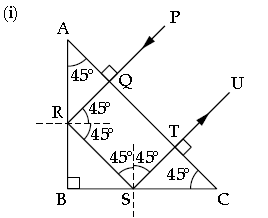
(ii) The value of the angle of deviation of the ray is 180.
(iii) Prism binocular.
Question: (i) What is meant by the term ‘critical angle’?
(ii) How is it related to the refractive index of the medium?
(iii) Does the depth of a tank of water appear to change or remain the same when viewed normally from above?
Answer: (i) The angle of incidence in the denser medium for which the angle of refraction in the rarer medium is 90 is called critical angle.
(ii) The relation between refractive index of the medium and critical angle is
μ = 1 / sin ic
(iii) No, when the depth of a tank of water is viewed normally, no refraction takes place. Therefore, the depth of the tank remains the same.
Question: (i) State the laws of refraction of light.
(ii) Write a relation between the angle of incidence
(i), angle of emergence (e), angle of prism (A) and the angle of deviation (δ) for a ray of light passing through an equilateral prism.
Answer: (i) The laws of refraction are as :
(a) The incident ray, the refracted ray and the normal at the point of incidence, all lie in the same plane.
(b) The ratio of sine of angle of incidence to the sine of angle of refraction is a constant for a pair of media. This constant is known
as refractive index i.e., μ = sin i / sin r
(ii) For a ray of light passing through an equilateral prism,
∠i + ∠e = ∠A + ∠S
Question: A stick partly immersed in water appears to be bent. Draw a ray diagram to show the bending of
the stick when placed in water viewed obliquely from above.
Answer:

Question: A ray of monochromatic light is incident from air on a glass slab.
(i) Draw a labelled ray diagram showing the change in the path of the ray till it emerges from the glass slab.
(ii) Name the two rays that are parallel to each other.
(iii) Mark the lateral displacement in your diagram.
Answer: (i) The ray diagram is shown below.

(ii) The incident ray produced and the emergent ray are parallel to each other.
(iii) Lateral displacement is shown in the diagram.
Question: How does the value of angle of deviation produced by a prism change with an increase in the
(i) Value of angle of incidence?
(ii) Wavelength of incident light?
Answer: (i) As the value of angle of incidence increases, there is a decrease in the angle of deviation
for a certain value of angle of incidence until, the angle of deviation becomes minimum after which it starts rising with further increase in the value of angle of incidence.
(ii) When the wavelength of the light increases, the angle of deviation decreases.
Question: (i) Draw a labelled ray diagram to illustrate (a) critical angle (b) total internal reflection for
a ray of light moving from one medium to another.
(ii) Write a formula to express the relationship between refractive index of the denser medium with respect to rarer medium and its critical angle for that pair of media.
Answer: (i) The labelled diagram of critical angle and total internal reflection is given below.

(ii) The formula to express the relationship between refractive index of the denser medium w.r.t.
rarer medium and critical angle is given by
μ = 1 / sin ic = cosec ic
Question: The diagram shows a right-angled prism with a ray of light incident on the side AB. (The critical angle for glass is 42°).

(i) Copy the diagram and complete the path of the ray of light in and out of the glass prism.
(ii) What is the value of the angle of deviation shown by the ray?
Answer: (i) The diagram below shows the complete path of the ray of light in and out of the glass prism.
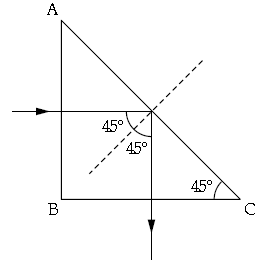
(ii) The value of the angle of deviation shown by the ray is 90°.
Question: (i) Two isosceles right-angled prisms are arranged as shown in the figure. Copy the
diagram and complete the path of the ray AB along which it passes through the prisms and comes out.
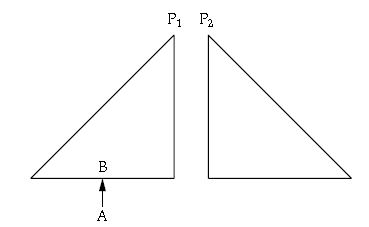
(ii) Name the phenomenon being displayed by the path of the ray in the diagram.
Answer:
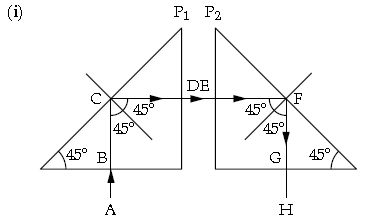
(ii) The phenomenon of total internal reflection takes place in both the prisms.
Question: A prism deviates a monochromatic ray of light through an angle δ, where the angle of incidence
at the surface of the prism is i.
(i) Draw a graph showing the variation of δ with i. On your graph, show the angle of minimum deviation.
(ii) What is the relation between the angle of incidence and the angle of emergence when the ray suffers minimum deviation.
Sol. (i) The graph between angle of deviation (δ) and
angle of incidence (i) is shown below

(ii) The angle of incidence (i) is equal to the angle of emergence (e) when the ray suffers a minimum deviation.
Long Answer Type Questions
Question: The diagram below shows a point source P inside a water container. Four rays A, B, C, D starting
from the source P are shown up to the water surface.
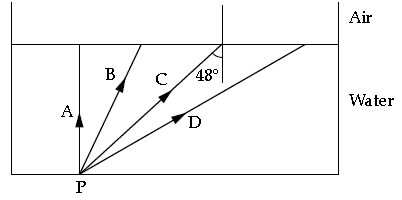
(i) Show in the diagram the path of these rays after striking the water surface. The Critical Angle for water air surface is 48°.
(ii) Name the phenomenon which the rays B and D exhibit.
Answer:

(ii) Ray B exhibits refraction. Ray D exhibits total internal reflection.
Question: (i) Name any four regions of electromagnetic spectrum in increasing order of frequency.
(ii) Calculate the refractive index of a liquid with respect to air applying Snell’s law (use geometric construction).

Answer: (i) Infra-red <visible <ultraviolet <X-ray

Angle of incidence (i) = 60°.
Angle of refraction (r) = 45°.

Question: Jatin puts a pencil into a glass container having water and is surprised to see the pencil in a
different state.
(i) What change is observed in the appearance of the pencil?
(ii) Name the phenomenon responsible for the change.
(iii) Draw a ray diagram showing how the eyes sees the pencil.
Answer: (i) The pencil will be seen bent.
(ii) Refraction of light.

Question: The given diagram shows a ray of light incident on an equilateral glass prism place in a minimum deviation position.

(i) Copy the diagram and complete it to show the path of the refracted ray and the emergent ray.
(ii) How are angle of incidence and angle of emergence related to each other in this position of prism?
Answer: (i) The diagram is redrawn to show the path of refracted rays and emergent rays.

(ii) The angle of incidence angle of emergence.
i.e., ∠i = ∠e
Question: (i) With the help of a well-labelled diagram, show that the apparent depth of an object such as a coin in water is less than its real depth.
(ii) How is the refractive index of water related to the real depth and the apparent depth of a column of water?
answer: (i) A ray from bottom of the tank A (coin) is striking normally at B goes straight.
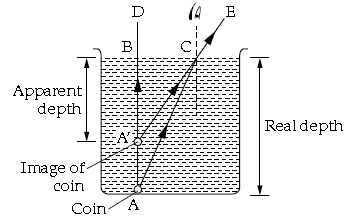
Another ray from A striking the interface at C is refracted towards E and when produced back, it appears to come from A′. When BD and CE enter the eye, these form an image of A (coin) at A′ (coin). Thus, the depth appears to be at A’B instead of the actual AB.
(ii) The refractive index of water related to the real depth and the apparent depth of a column of water is given by
Refractive index, μ = Real depth/ Apparent depth
Question: PQ and PR are two light rays emerging from the object P as shown in the figure.
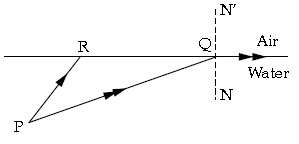
(i) What is the special name given to the angle of incidence (∠PQN) of ray PQ?
(ii) Copy the ray diagram and complete it to show the position of the image of the object P, when
seen obliquely from above.
(iii) Name the phenomenon that occurs, if the angle of incidence ∠PQN is increased still further.
Answer: (i) The special name given to the angle of incidence ∠PQN of ray PQ is critical angle.
(ii) The complete diagram is shown below.

The image of the object P will be formed at P′, when seen obliquely from above.
(iii) Total internal reflection occurs, if the angle of incidence ∠PQN is increased still further.
Question: (i) What is meant by refraction ?
(ii) Express the refractive index n of a medium.
(a) In terms of the velocity of light.
(b) In terms of the angle of incidence i in air, the angle of refraction in a denser medium.
(iii) If a ray of light passes from medium I to medium II without any change of direction.
What can be said about the refractive indices of these media (Angle i is not 0)?
Answer: (i) When a ray of light passes from one medium to the other medium, it changes its path, This
phenomenon is called refraction of light.
(ii) (a) Refractive index of second medium w.r.t. first medium,
1μ2 = Velocity of light in the first medium / Velocity of light in the second medium
(b) Refractive index of second medium w.r.t. first medium,
1μ2 = sin i / sin r
(iii) If a ray of light passes from one medium to other medium without any change of direction/path even when angle i is not zero, then the refractive index of two mediums must be equal.
Question: (i) Define ‘critical angle’.
(ii) A ray of light passes through a right angled prism as shown in the figure. State the angles of incidence at the faces of AC and BC.

Answer: (i) The angle if incidence in the denser medium for which the angle of refraction in the rarer
medium is 90° is called critical angle.
(ii) Angle of incidence at face AC = 45° Angle of incidence at face BC = 0°

Question: (i) State snell’s laws.
(ii) Calculate the velocity of light in a glass block of refractive index 1.5 (velocity of light in air = 3 × 108 m/s)
Answer: (i) Snell’s law : The ratio of sine of angle of incidence to the sine of angle of refraction for a given pair of media is constant. This constant is called refractive index for the pair of media.
(ii) Given refractive index μ = 1.5,
Velocity of light in air c = 3 × 108 m/s
Velocity of light in glass v = ?

Question: A postage stamp appears raised by 7.0 mm, when placed under a rectangular glass block of refractive index 1.5 Find the thickness of the glass block.
Answer: Given refractive index μ = 1.5
Thickness x = ?, Shift = 7 mm

Question: (i) In the given diagram, a ray if light PQ is incident normally on one face AB of an equilateral glass prism. What are the angle of incidence at the faces AB and AC?
(ii) Complete the ray diagram showing its emergence into air after passing through the prism.
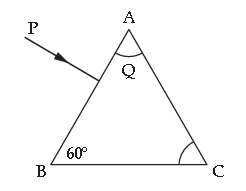
Answer: (i) The angle of incidence at the face AB is 0°.
The angle if incidence at the face AC is 60°.

Question: A monochromatic point source of light O is seen through a rectangular glass block ABCD. Paths of
two rays, in and outside the block, are shown in the figure below.
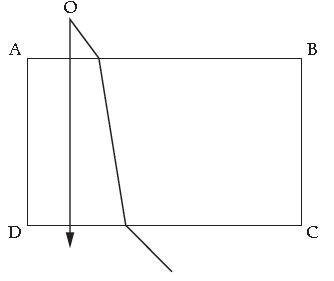
(i) Does the source at point O appear to be nearer or farther with respect to the surface AB?
(ii) How does the shift depend on the thickness (AD or BC) of the block?
(iii) Justify your answer with the help of an appropriate ray diagram as shown in figure.
(iv) For the same rectangular glass block, which colour from the visible spectra will produce the maximum shift?
Answer: (i) The sources O appear to be nearer w.r.t the surface AB.
(ii) The shift is directly proportional to the thickness of glass slab, so the shift decreases with decrease in the thickness of glass slab.

(iv) The refractive index of glass is minimum for red light and maximum for violet light i.e., Mv > Mr, Therefore, for the same rectangular glass block, violet colour in the visible spectra will produce maximum shift.
Refraction Through a Lens
Short Answer Type Questions I
Question: Ranbir claims to have obtained an image twice the size of the object with a concave lens. Is he
correct? Give reason for your answer.
Answer: No, he is not correct because concave lens produce highly diminished virtual and erect image.
Question: You are provided with a printed piece of paper. Using this paper, how will you differentiate between a convex lens and concave lens?
Answer: When the printed piece of paper is moved near the both lenses, if the letters appear as
(i) Erect and diminished, the lens is concave lens.
(ii) Erect and magnified, the lens is convex lens.
Question: (i) When does a ray of light falling on a lens pass through it undeviated?
(ii) Which lens can produce a real and inverted image of an object?
Answer: (i) A ray of light parallel to the principal axis of convex lens when passes through the optical centre then the ray coming out from the lens will be undeviated.
(ii) A real and inverted image of an object can be produced by using convex lens or converging lens.
Question: We can burn a piece of paper by focusing the sun rays by using a particular type of lens.
(i) Name the type of lens used for the above purpose.
(ii) Draw a ray diagram to support your answer.
Answer: (i) The convex lens is used.
(ii) The ray diagram is shown below :
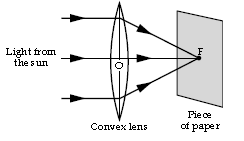
Question: Copy and compete the following table.

Answer:

Question: Draw a diagram to illustrate the determination of the focal length of a convex lens using an auxiliary
plane mirror.
Answer: Focal length = x + y / 2

Question: An object is placed in front of a conversing lens at a distance greater than twice the focal length of the
lens. Draw a ray diagram show to the formation of the image.
Answer: The ray diagram showing the formation of the image is shown in figure.

Question: An object is placed in front of a convex lens such that image formed has the same size as that of the
object. Draw a ray diagram to illustrate this.
Answer: The ray diagram to show the formation of the image having same size as that of object is shown below.

Question: A ray of light, after refracting through a concave lens, emerges parallel to the principal axis. Draw a ray diagram to show the incident ray and its corresponding emergent ray.
Answer: The ray diagram to show the incident ray and its corresponding emergent rays is shown below
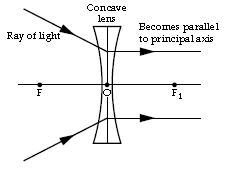
Question: The diagram shows a point source of light s, a convex lens L and plane mirror M. These are placed such that rays of light from S return to it after reflection from M.

(i) what is the distance OS called?
(ii) To which point (left of S or right S) will the rays return, if M is moved to the left and brought in contact with L?
Answer: (i) The distance OS is called focal length of the lens.
(ii) The rays will be on S, if M is moved to the left and brought in contact with L.
Short Answer Type Questions II
Question: A lens forms an upright and diminished image of an object when the object is placed at the focal point of the given lens.
(i) Name the lens.
(ii) Draw a ray diagram to show the image formation.
Answer: (i) Concave lens

Question
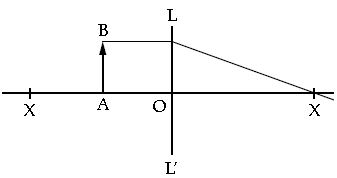
(i) Copy and complete the ray diagram to show the information of the image of the object AB
(ii) Name the lens LL′.
(iii) Name a device in which this principle is used.
Answer: X is the focus of lens and object is placed within the focus of the lens. The ray is converging, so the lens
is a convex lens

(ii) The lens LL′ is convex lens.
(iii) This principle is used in magnifying glass.
Question:. A lens produces a virtual image between the object and the lens.
(i) Name the lens.
(ii) Draw a ray diagram to show the formation of this image. \
Answer: (i) Concave lens

Q. 4. (i) Where an object should be placed so that a real and inverted image of the same as object
is obtained using a convex lens?
(ii) Draw a ray diagram to show the formation of the image as specified in the part (i)
Answer: (i) At 2F1 or centre of curvature

Question: A lens forms an erect, magnified and virtual image of an object.
(i) Name the lens.
(ii) Draw a labelled ray diagram to show the image formation.
Sol. (i) Convex.
Detailed Answer :

Question: (i) Define the power of a lens.
(ii) A lens has focal length 25 cm. Calculate the power of lens.
Answer: (i) It is the measure of deviation produced in the path of light when it passes through the lens.
(ii) 1 / F = 100 / 25
P = +4 D
Question: (i) Copy and complete the diagram to show the formation of the image of an object AB.
(ii) What is the name given to X?
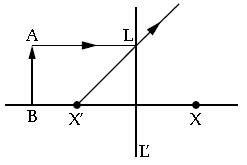
Answer: (i) The ray diagram showing the formation of the image (A’B’) of the object AB is shown below.

(ii) X is the principal focus.
Question: A linear object is placed on the axis of a lens. An image is formed by refraction in the lens. For all
positions of the object on the axis of the lens, the positions of the image are always between the lens and the object.
(i) Name the lens.
(ii) Draw a ray diagram to show the formation of the image of an object placed in front of the lens at any position of your choice except infinity.
Answer: (i) The lens is concave lens.
(ii) The ray diagram showing the formation of image is shown below

The object is placed between focus (F) and 2F.
Question: The given ray diagram illustrates the experimental set up for the determination of the focal length of
a converging lens using a plane mirror.

(i) State the magnification of the image formed.
(ii) Write two characteristics of the image formed.
(iii) What is the name given to the distance between the object and optical centre of the lens in the given diagram?
Answer (i) As the distance of image from lens is same as that of object, its magnification is equal to one.

(ii) The image formed is real, inverted and of same size as that of object.
(iii) The distance between the object and optical centre of the lens is named as focal length of the lens.
Question: State three characteristics of the image of an extended source, formed by a concave lens.
Answer: The three characteristics of the image of an extended source formed by a concave lens are
(i) Virtual
(ii) Erect
(iii) Highly diminished, if the object is at infinity/ diminished, if the object is between optical centre and infinity.
Long Answer Type Questions
Question: An object AB is placed between 2F and F on the principal axis of a convex lens as shown in the diagram.
Copy the diagram and using these rays starting from point A, obtain the image of the object formed by the lens.

Answer: The formation of image is shown in fig.

Question: A converging lens is used to obtain an image of an object placed in front of it. The inverted image is
formed between F2 and 2F2 of the lens.
(i) Where is the object placed?
(ii) Draw a ray diagram to illustrate the formation of the image obtained.
Answer: (i) The object is placed beyond 2F1.
(ii) The ray diagram to illustrate the formation of the image is shown below

Question: An object is placed infront of a lens between its optical centre and the focus and forms a virtual,
erect and diminished image
(i) Name the lens which forms this image.
(ii) Draw a ray diagram to show the formation of the image with the above stated characteristics.
Answer: (i) This image is formed by using concave lens.
(iii) The ray diagram to show the formation of the image is shown below.

Question: An erect, magnified and virtual image is formed when an object is placed between the optical
centre and principal focus of a lens.
(i) Name the lens.
(ii) Draw a ray diagram to show the formation of the image with the above stated characteristics.
Answer; (i) The lens used is convex lens.
(ii) The ray diagram to show the formation of the image with the above characteristics is shown below

Question: The diagram given below shows an object O and its image I. Copy the diagram and draw suitable
rays to locate the lens and its focus. Name the type of lens in this case.
Answer: The ray diagram is shown as below

The lens used is convex lens.
Question: An erect, diminished and virtual image is formed when an object is placed between the optical
centre and principal focus of a lens.
(i) Name the type of lens, which forms the above image.
(ii) Draw a ray diagram to show the formation of the image with the above characteristics.
Answer: (i) The type of lens used is concave lens.
(ii) The ray diagram showing the formation of image is shown below.
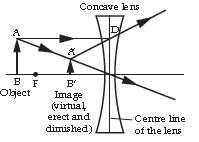
Question: In an optical camera,
(i) State the nature of the lens used.
(ii) What is meant by f-number?
(iii) State two characteristics of the image formed by the lens.
Answer: (i) The nature of the lens used is convex lens.
(ii) f-number is the size of aperture through which light enters the camera. It is expressed as :
f-number = Focal length of the camera lens / Diameter of the aperture
(iii) The two characteristics of the image formed by the lens are real and inverted. 1+2+1
Question: Draw a ray diagram to illustrate the action of a convergent lens as a reading lens or a magnifying glass.
Answer: A convex lens of small focal length can be used as a reading glass or a magnifying glass. When an object
is placed within the focal length of the lens, then a virtual, erect and magnified image is formed.
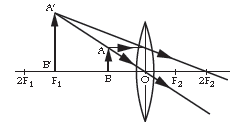
Spectrum and Scattering of Light
Very Short Answer Type Questions
Question: Which characteristic property of light is responsible for blue colour of sky?
answer: Scattering of Light.
Question: Name the subjective property of light related to its wavelength.
Answer: Colour of light
Question: Fill in the blanks;
A piece of red cloth appear red in white light, because it …………………………… blue and green colours ……………………. only red colour.
Answer: Absorbs, reflects
Short Answer Type Questions 1
Question: Calculate the wavelength of an electromagnetic wave of frequency 15 MHz.
Answer: Velocity = Wavelength × Frequency
Wavelength = Velocity / Frequency
Given, frequency = 15 MHz = 15 × 106 Hz.
Velocity = 3 × 108 m/s

Question: (i) Name the prism required for obtaining spectrum of ultraviolet light.
(ii) Name the radiation which can be detected by a thermopile
Answer: (i) Quartz prism is required for obtaining a spectrum of ultraviolet light.
(ii) Infrared radiations can be detected by a thermopile.
Question: Why is red colour used as a sign of danger?
Answer: The scattering of light is inversely proportional to the fourth power of the wavelength of light. This
scattering of red light is much less than other colours of light. Therefore, red colour signals can be seen upto a longer distance
Question: (i) What is meant by dispersion of light?
(ii) In the atmosphere, which colour of light gets scattered least?
Answer: (i) The phenomenon of splitting of white light while passing through a prism, into its constituent colours is known as dispersion of light.
(ii) Red colour of light scatters least.
Question: (i) Why is white light considered to be polychromatic in nature?
(ii) Give the range of the wavelength of those electromagnetic waves which are visible to us.
Answer: (i) Polychromatic light consists of many colours each having its characteristic wavelength.
White colour is polychromatic light, because white light is made up of seven colours i.e., VIBGYOR.
(ii) The range of 4000 Å to 7800 Å wavelength of electromagnetic wave is visible to us.
Question: Why are infrared radiations preferred over ordinary visible light for taking photographs in fog?
Answer: Infrared radiations are used for photography in fog, because they are not much scattered by mist or
fog and can penetrate through fog, so photography can be done easily.
Question: A particular type of high energy invisible electromagnetic wave help us to study the structure of crystals. Name these rays and give another important use of these rays.
Answer: The rays discussed are X-rays. The important use of X-rays is to detect the fracture of bone, teeth, etc. 2
Question:. Explain briefly what causes the twinkling of stars at night?
Answer: The twinkling of a star is due to atmospheric refraction of starlight. As the light from the star enters the earth’s atmosphere, it undergoes refraction due to varying optical densities of air at various altitudes. The continuously changing atmosphere refracts the light by different amounts. In this way, the starlight reaching our eyes increases and decreases continuously and the star appears to twinkle at night.
Question: Name any two electromagnetic waves, which have a frequency higher than that of violet light. State
one use of each.
Answer: The two electromagnetic waves which have a higher frequency than that of violet light and their uses are :
(i) X-rays having the frequency of 3 X 1016 Hz. They are used for detection of fracture.
(ii) γ-rays having the frequency of 3 X 1019 Hz. They are used in medical sciences to kill cancer cells.
Short Answer Type Questions II
Question: (i) Why does the Sun appear red at sunrise?
(ii) Name the subjective property of light related to its wavelength.
Answer: (i) At sunrise light has to travel longest distance in atmosphere, blue light gets scattered more and is lost.
Red light has long wavelength, scatters the least and reaches the observer.
(ii) Colour of light
Question: A type of electromagnetic wave has wavelength 50 Å
(i) Name the wave.
(ii) What is the speed of the wave in vacuum?
(iii) State one use of this type of wave.
Answer: (i) The wave is X-rays as its range is 0.1 Å to 100 Å.
(ii) The speed of light in vacuum is 3 × 108 m/s.
(iii) They are used for detection of fractures in bone, teeth, etc
Question:. Name the radiations :
(i) That are used for photography at night.
(ii) Used for detection of fracture in bones.
(iii) Which wavelength range is from 10 nm to 400 nm.
Answer: (i) Infrared radiations are used for photography at night.
(ii) X-rays are used for detection of fracture in bones.
(iii) Ultraviolet rays which have wavelength in range from 10 nm to 400 nm.
Question: (i) Suggest one way in each case by which we can detect the presence of
(a) Infrared radiations
(b) Ultraviolet radiations
(ii) Give one use of infrared radiations.
Answer: (i) (a) Infrared radiation : By using a thermopile or a blackened bulb thermometer.
(b) Ultraviolet radiation : By using silver chloride solution.
(ii) They are used in muscular therapy and for taking photographs in fog.
Question: Two parallel rays of red and violet light travelling through air, meet the air glass boundary as shown
in the given figure.

(i) Will their paths inside the glass be parallel? Give a reason for your answer.
(ii) Compare the speeds of the two rays inside the glass.
Answer:

(i) No, the paths of two parallel rays of red and violet colour travelling through glass will not be parallel, because on entering the glass both the rays deviate to different extents i.e., r1 > r2.
(ii) The red colour deviates less while violet colour deviates more. Therefore, the speed of red colour in glass is more than the speed of violet colour in glass i.e., vviolet < vred
Question: Give one use of each of the electromagnetic radiations given below :
(i) Microwave,
(ii) Ultraviolet radiation,
(iii) Infrared radiation,
Answer: (i) Microwaves are used for satellite communication and radar communication.
(ii) Ultraviolet radiations are used for sterilizing purposes and detecting the purity.
(iii) Infrared radiations are used for photography at night in mist or fog.
Question: (i) A glass slab is placed over a page on which the word VIBGYOR is printed with each letter in its corresponding colour.
(a) Will the image of all the letters be the same plane?
(b) If not, state which letter will be raised to the maximum. Give a reason for your answer.
(ii) What will be the colour of an object which appears green in white light and black in red light?
Answer: (i) (a) No, the image of all the letters are not in the same plane, because the letter of each colour have different frequency.
(b) The letter V for violet is raised more, because Y is least for violet colour.
(ii) The colour of an object which appears green in white light and black in red light will be green.
Question: (i) If a monochromatic beam of light, undergoes minimum deviation through a triangular
prism, how does the beam pass through the prism, with respect to its base?
(ii) If white light is used in the same way as in
(i) above, what change is expected in the emergent beam?
Answer: (i) If a monochromatic beam of light undergoes minimum deviation through an equiangular prism.
The angle of incidence i is equal to the angle of emergence e (∠i = ∠e.) Hence, the refracted beam passes parallel to
the base of the prism.
(ii) If white light is used in the same way as in part
(i), then dispersion of light takes place. We know that the angle of deviation depends on the wavelength of light. The refractive index of a given transparent material decreases with the wavelength of increase in the light. Consequently, the given prism deviates the violet light more than the red light.
Long Answer Type Questions
Question: What do you understand by the term ‘Scattering of light’? Which colour of white light is scattered
the least and why?
Answer: Absorption and remission of light without the change in the wavelength. Red as its λ is high.
Question: Name any four regions of electromagnetic spectrum (other than visible light) in increasing order of their wavelength.
Answer: The four regions of electromagnetic spectrum in increasing order of wavelengths are γ-rays, X-rays,
ultraviolet rays and infrared rays.
Question: (i) Explain, why in daylight an object appears red when seen through a red glass and black when
seen through a blue glass?
(ii) Name the extreme colours in pure spectrum of light.
Answer: (i) In day or white light, when an object is seen through a red glass, it transmits only red light,
because it reflects only red light. But when the same object is seen through blue glass, the red light reflects by the object is not transmitted through the blue glass and the object appears black since, no light reaches to our eyes.
(ii) The extreme colours of a pure spectrum are violet at one end and red at the other end.



